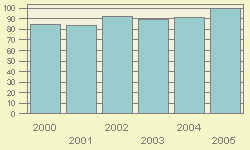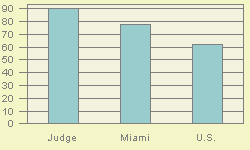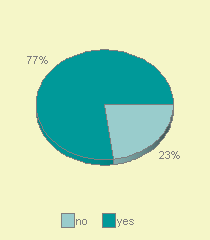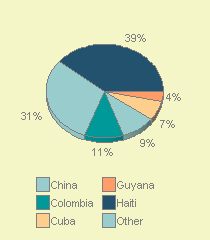Judge Kenneth S. Hurewitz
Judge Hurewitz was appointed as an Immigration Judge in March 1996. He received a Bachelor of Science degree from State University of New York at Stony Brook in 1971, and a Juris Doctorate from the University of Toledo in 1973. From 1974 to 1996, he served as a trial attorney for the former Immigration and Naturalization Service in Miami. Judge Hurewitz is a member of both the Michigan and Ohio Bars.
Deciding Asylum Cases
Detailed data on Judge Hurewitz decisions are available for the period covering fiscal year 2000 through the early months of 2005. During this period, Judge Hurewitz is recorded as deciding 631 asylum claims on their merits. Of these, he granted 56, gave 7 conditional grants, and denied 568. Converted to percentage terms, Hurewitz denied 90 percent and granted (including conditional grants) 10 percent. Figure 1 provides a comparison of Judge Hurewitz 's denial rate fiscal year-by-year over this recent period.
Nationwide Comparisons
Compared to Judge Hurewitz 's denial rate of 90, nationally during this same period, immigration court judges denied 61.9 percent of asylum claims. In the Miami Immigration Court where Judge Hurewitz was usually based, judges there denied asylum 77.3 % of the time. See Figure 2.
Judge Hurewitz can also be ranked compared to each of the 224 individual immigration judges serving during this period who rendered at least one hundred decisions. If judges were ranked from 1 to 224 - where 1 represented the highest denial percent and 224 represented the lowest - Judge Hurewitz receives a rank of 15. That is 14 judges denied asylum at higher rates, and 209 denied asylum the at the same rate or less often.
Why Do Denial Rates Vary Among Judges?
Denial rates reflect in part the differing composition of cases assigned to different immigration judges. For example, being represented in court and the nationality of the asylum seeker appear to often impact decision outcome. Decisions also appear to reflect in part the personal perspective that the judge brings to the bench.
Representation
If an asylum seeker is not represented by an attorney, almost all (93%) of them are denied asylum. In contrast, a significantly higher proportion of represented asylum seekers are successful. In the case of Judge Hurewitz , 22.8 % were not represented by an attorney. See Figure 3. For the nation as a whole, about 9.2 % asylum seekers are not represented.
Nationality
Asylum seekers are a diverse group. Over one hundred different nationalities had at least one hundred individuals claiming asylum decided during this period. As might be expected, immigration courts located in different parts of the country tend to have proportionately larger shares from some countries than from others. And, given the required legal grounds for a successful asylum claim, asylum seekers from some nations tend to be more successful than others.
For Judge Hurewitz , the largest group of asylum seekers appearing before him came from Haiti . Individuals from this nation made up 39 % of his caseload. Other nationalities in descending order of frequency appearing before Judge Hurewitz were: Colombia (10.7 %), China (9.3%), Cuba (6.9%), Guyana (3.6%). See Figure 4.
In the nation as a whole during this same period, major nationalities of asylum seekers, in descending order of frequency, were China (22.3%), Haiti (9.3%), Colombia (9.1%), Albania (4.0%), India (3.9%), Guatemala (3.4%), Indonesia (3.0%), El Salvador (2.4%), Armenia (2.1%), Mexico (1.9%), and Russia (1.9%).




